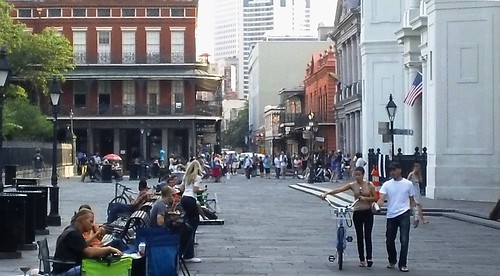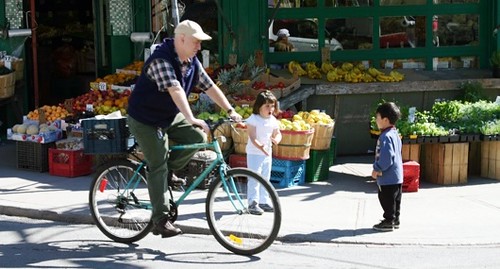The importance of place to sustainability

Posted July 12, 2011 at 1:45PM
I find that I am almost always thinking about the quality of places. Hanging out with the likes of David Dixon, Victor Dover, and Steve Mouzon will do that to you. And I am especially thinking about places - as a concept - this week, because on Friday I was told that a presentation on NRDC’s sustainable communities agenda is actually due on July 18, not July 26 as I had been thinking and planning. Yikes.
So I need to get my act together, because this is an important audience: my NRDC colleagues. A friendly but seriously demanding bunch, to a person.
To me advocacy for sustainable communities is fundamentally about place: advocacy for environmental solutions in the human environments where we live, work and play. Now there’s a certain ambiguity in that concept, which is helpful when one is describing a diverse if strong agenda being carried out by staff in five US cities and working at all scales of government and with the private sector.
 That said, I think of our work as bringing sound environmental practice to three scales of place: (1) the metropolitan region, where so much of our economic activity and our living and transportation patterns are anchored; (2) the municipality - be it city, county, or suburb - which, although not particularly defining when it comes to the environment or economy, is critical politically for getting things done; and (3) the neighborhood, where increments of growth and placemaking actually occur and where most of us interact with our communities and our environment on a daily basis.
That said, I think of our work as bringing sound environmental practice to three scales of place: (1) the metropolitan region, where so much of our economic activity and our living and transportation patterns are anchored; (2) the municipality - be it city, county, or suburb - which, although not particularly defining when it comes to the environment or economy, is critical politically for getting things done; and (3) the neighborhood, where increments of growth and placemaking actually occur and where most of us interact with our communities and our environment on a daily basis.
I think the neighborhood scale is where the environmental movement has tended to be somewhat weak over the years. There is a feeling, not entirely unjustified, that especially for national groups like NRDC we can squander our acutely limited resources by focusing on small, individual places. Yet the argument breaks down when one considers that, historically, environmental groups have always been involved in place-based test cases, such as particular wilderness areas threatened by resource exploitation or ecological habitat threatened by highways or oil spills. The truth is that we have never hesitated to focus on places to protect them from harm; why not also focus on places - particularly urban places - as models for what we can do right?
Ethan Kent of the Project for Public Spaces would likely agree. In an article titled “Placemaking as a New Environmentalism,” Kent writes:
“It is in fact these immediate environments that humans most directly interact with and experience, and it is this place level or community scale that Environmentalism has largely ignored. We can perhaps best ramp people onto a broader environmental agenda through engaging them in and challenging them to take responsibility for and shape these public realms beyond their homes. This is a process we call Placemaking, which is dedicated to encouraging and empowering people to take ownership over and contribute to the world beyond their private property and work together to improve them. Placemaking is the common sense process through which the human places we most value are created and sustained.
“Only by helping people connect to, care for and shape the world beyond their front doors will we be able to instill people with a capacity to redress the larger environmental crises.
Incorporating Placemaking as an essential element of Environmentalism will lead to a reinvention of citizenship and the discovery of new tools and strategies to change the world.”
Kent argues that it is not enough to ask whether an action or proposal is doing or likely to do harm: we must also ask whether it is contributing positively to the enhancement of our “environmental, community, social, cultural, historical, and economic” surroundings.
Phil Myrick, also of PPS, elaborates in a sort of companion article, “The Power of Place: A New Dimension for Sustainable Development.” Myrick writes:
“We feel it is important to give people a proactive approach to sustainability in their hometowns. Creating lively town centers and neighborhoods that enhance pride of place and promote local economic development is critical to improving local quality of life as well as quality of the environment. In fact, we can reinvent entire regions starting from the heart of local communities and building outwards.”
I couldn’t agree more, and that premise is a huge reason why I wanted to be part of NRDC’s sustainable communities initiative when our organization, at last, identified it as one of our strategic priorities for the next five years.
As I have written before, a big part of my professional growth was finding answers to a question that had been eating me alive after I tired of being an adversarial advocate: what is it that we can say yes to? While we should all be glad that many of my colleagues in NRDC and other parts of the environmental community are fighting environmental harm and stupidity with great skill and dedication, that was no longer enough for me personally after some 20 years as a litigation lawyer.
The power of saying yes to sustainable community places was why I dedicated so much of the last decade to working with organizational partners and immensely gifted individuals to craft LEED for Neighborhood Development, an imperfect but terrific first step to define what is smart and green about smart, green development. It is why I worked with Enterprise Community Partners to help them develop the Green Communities program for sustainable affordable housing, and why I am now working with the Local Initiatives Support Corporation to undertake model green, inclusive revitalization of distressed neighborhoods and to develop templates to help others do the same.
Because, when you come down to it, there is no sustainability without sustainable places that help limit environmental impacts while also nourishing the human spirit. There is nothing I would rather do than help create them.
Move your cursor over the images for credit information.


